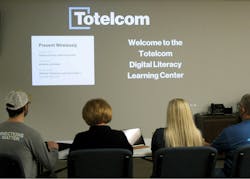Executive Insights With Jennifer Prather, CEO, Totelcom Communications, LLC
Now, more than ever, it is imperative to acknowledge the obstacles that hinder progress in deploying high-speed broadband to rural communities. That’s why this interview with Jennifer is so refreshing. She openly addresses the issues and suggests solutions to bridge the digital divide and bring equal opportunities to rural areas.
Take a few moments to soak in how Jennifer shares her opinion in a way that allows us to hear her message. I respect how she embraces what Ruth Bader Ginsburg, a Supreme Court Justice, once said, “Fight for the things that you care about but do it in a way that will lead others to join you.”
Topic: Telecom Trends
ISE: How do you see emerging technologies such as 5G, IoT, and edge computing shaping the telecom landscape across rural America in the coming years?
Jennifer Prather: Rural America is primed for use cases and an excellent place to test emerging tech. We have lots of open space, energy, and hardworking individuals in rural areas. We need to be connected to things that previously required a physical connection but can now be done remotely, such as healthcare, education, and commerce. Access to robust and reliable internet connectivity allows our rural areas to grow. With the arrival of remote work at a more universal level, consumers can choose to live in a more remote or rural area. Their arrival, in turn, requires us to do our job well. We must keep our service reliable, robust, and growing with them—or they won’t stay.
Edge computing is an opportunity for rural carriers because we already have empty real estate with robust air conditioning, backup power, and resilient large-capacity networks in our old switch remote locations. All these emerging technologies require larger data capacity, only furthering the need for robust, resilient, and future-proof connections in rural America. To be ready for whatever comes next, we need fiber deployed and ready.
Topic: FWA and FTTP
ISE: Share your perspective about the interplay between these two technologies when working to deliver gigabit speeds to serve hard-to-reach customers.
Prather: Totelcom utilizes every tool available to serve our hardest-to-reach customers, including fixed wireless technologies. Every type of service technology has pros and cons.
In our experience, fixed wireless has been a tool to enter a new market quicker and more cost-effectively before deploying fiber, and we also utilize it to serve some of our most remote customers. Providing a quality fixed wireless experience still takes a lot of fiber. The backhaul and capacity needs of some of those most remote consumers, including energy production/monitoring and agriculture production, continue to challenge fixed wireless.
Even with the deployment of next-gen fixed wireless, our goal remains to get wired connectivity to all these customers eventually—because of some of the cons of the service. Namely, the ongoing maintenance has proven to be greater in time and expense than a wired fiber optic network. Even with the purported reduced next-gen line of site requirements, weather can still interfere with the service. We must replace units at network access points and customer locations that take direct lightning strikes or intense wind bursts each spring. Depending on when these outages occur, it can also limit our ability to address them until the weather has passed.
I also worry about the long-term viability and capacity of spectrum as more wireless tech emerges for the end consumer. Any wireless product, including next-gen fixed wireless and 5G, requires robust wired networks for backhaul between the wireless access points and the core network. This requires fiber to be already branched out to a certain extent, likely close enough to the end consumer to mitigate the cost differential of wired end-user access over a long-term feasibility calculation.
Long-term service plans to consumers must consider all these factors, and with the current funding environment promoting dollars for fiber deployment, it’s a time to try to get as much fiber out as possible and limit our reliance on spectrum-based technologies.
Topic: Permitting and Easements
ISE: There’s been much debate in D.C. about permitting and other approval processes that can result in significant deployment delays and cost increases. What would help solve these challenges?
Prather: Permitting challenges have proven to be a significant barrier for some of our fiber deployment projects. One major point I see is the lack of the permitting authorities, including fellow utility providers or federal or state regulatory agencies, to adequately prepare for the staffing levels needed to process the increased permitting applications in our current environment. This delays projects and increases costs, as many are turning to third-party consultants who do a lesser-quality job at a much higher price.
We have had third-party assessors turn in expensive yet inaccurate make-ready assessments that ultimately impacted the safety of our construction crews. This cannot continue. More can be done and is being done to address the issue with a sensible approach, such as expedited approvals for previously disturbed areas and updates to prior infrastructure. Continuing with this kind of common sense and cooperative approach will still help, even if a little too late.
Topic: Operational Realities
ISE: ICT industry analysts and observers often focus on CAPEX budgets. But the reality is that OPEX can make or break the bottom line. The key to controlling OPEX is cost-efficiently improving network life cycle management for complex fiber and legacy networks. How is Totelcom reducing its OPEX?
Prather: We must be efficient with CAPEX due to the low density of the areas around us that remain un-served or under-served. However, OPEX is a real and constant challenge for us because of the economic reality of providing a high-quality service to low-density areas. There is only so much revenue per mile that can come from some of our capital plant investments because there are only so many potential customers!
At Totelcom, we focus on doing projects right the first time, constantly improving and streamlining our processes, and increasing the quality and reach of our virtual support offerings. This year, we have seen great success in doing more remote installs where customers receive a product such as an updated ONT with a QR code launched video to self-install their equipment. Changing our processes has also required our employee team to think outside the box and look for new ways to serve our customers better and more efficiently. We are always trying to balance being efficient in our expenses while continuing to give our customers the experience they demand.
Another thing I am proud of at Totelcom is our forward-looking approach to network capacity. This was really brought to our attention during the instant and intense network growth we saw during the COVID-19 pandemic. We had been preparing our network for this. Being ready instead of reactive costs much less than responding to the extra demand in a crisis. Everything we can do today to prepare for tomorrow decreases the strain of tomorrow’s unanticipated curveballs.
Topic: What Matters Most
ISE: You and your brother are the chiefs of Totelcom. On your website, you concisely explained why you do what you do: “We grew up here, we’re raising our families here, and we’re building a company here. We’re deeply rooted and passionately invested because we love our part of Texas and believe its people deserve the same opportunities found elsewhere.” What is the most important thing you can share with other leaders who work to advance their rural communities via broadband?
Prather: What we do is so cool, fun, and important to those around us. If you find yourself lucky enough to be in a similar position, keep that passion and remember why we work for our consumers. There is nothing better than seeing our service impact the lives of our friends and neighbors. At Totelcom, we don’t have shareholders or equity partners who dictate what we do—we have community members we see at the grocery store and school events.
We see our service's impact on the lives of those we love most. I keep them in mind when advocating for changes that positively impact our ability to serve more consumers with robust broadband and connect to the world.
Topic: The Elephant in the Room
ISE: What is the industry NOT addressing that it should related to network evolution and broadband for all?
Prather: One thing the industry is still hesitant to address is the ongoing need for operational expense support for low-density coverage and the cost-sharing that should come from all who benefit from universal connectivity. There will only be an economic market case to serve these areas with some form of smart, transparent, accountable, and ongoing support. Preparing for the post-BEAD era—in which the continued viability of rural connectivity that began with BEAD and other federal programs—will rely on an ongoing support mechanism.
Also, security practices for IoT devices are a serious issue that will cause consumer problems in the future. These devices are ripe for intrusion into a home network. For example, when did you last do a security patch on your Wi-Fi-connected washer? It’s a hard balance for an end user to ensure home network security while still being able to use the devices they want without a network engineering degree.
Topic: BEAD
ISE: Share your take on it and the realities for rural providers like Totelcom.
Prather: Totelcom sees BEAD as a potentially exciting opportunity, but with great concern, as we approach it. I appreciate the understanding that it will take public money to adequately close(ish) the digital divide that still exists across America—and not just in rural America. Allowing the money to be administered by the individual states creates opportunities and challenges as the plans are starting to roll out.
However, it sure seems to be getting bogged down by a lot of red tape that will prohibit many of the community-based rural providers from participating—the exact kinds of companies building in the hardest-to-reach and most cost-prohibitive areas already. I worry that not enough education for regulators and policymakers has been obtained from these types of companies, but instead by lobbyists from the companies that left these areas behind in the first place.
The rules should reflect what has worked in the many parts of rural America where robust broadband can be found today. Unfortunately, taking the cheap way out and creating more but subpar connections today will make for a continued problem into tomorrow. It will require a balance to address the number of consumers who remain unconnected with the overall cost guardrails of the program, and I’m glad it’s not my job to figure that out.
Topic: Converting Fiber Homes Passed to Homes Connected
ISE: Telecom providers still have trouble converting “homes passed” to “homes connected.” Only 20 countries worldwide currently have more than a 50% fiber penetration rate. What’s a feasible solution?
Prather: One thing that we see is a continued need for more affordable connections for low-income consumers. This is generally our surveyed highest response regarding a lack of subscription where connectivity is available. Unfortunately, the American Connectivity Program (ACP) seems destined to expire. This program has made a sizeable impact on our consumers. The reality is we are serving a combination of low-income and low-density areas, creating a bad math problem of revenues vs service costs.
While proud of our efficiency, we still require revenue to keep the services available. Other consumer utilities are all priced higher than our service, but a floor remains for us to remain operable. We do what we can to provide low income options, but we need the support of programs like the ACP to do what we can on our own. Low income broadband programs may be one of the only social programs that have a tangible impact on a consumer’s upward economic progress, as there are few jobs today that can be applied for without a connection to the internet. Discontinuing the ACP will only worsen the “available yet unconnected” problem.
Topic: Workforce Training Challenges Continue
ISE: McKinsey shared that our industry will experience significant talent challenges by 2027. Thankfully, training programs are now in place. How will these be effective and sustainable without an industry “standard” or “certification?” What should our industry do to remedy this?
Prather: Training programs and certifications are undoubtedly helpful. However, particularly in rural areas, we need to structure these to allow for on-the-job training. The statistics show that when students leave the area, they rarely return. Our industry should work more closely with local high schools and allow students to work in high-tech jobs right out of school, potentially even bypassing trade schools. Suppose they can learn while on the job. In that case, we can utilize the talent immediately, and their job duties and colleague interactions enhance their education through remote or virtual reality-based training programs. Upon completion of a certification, they would be eligible for promotions or pay increases and can continue in their career path while remaining local to the area.
This can be especially important for rural areas where it may not be financially feasible to go far to the nearest trade school or training center. Recently, VR Solutions company Transfr has been working with rural telecom experts to develop the rapid training simulations we need for our future workforce. They have created hands-on simulation training in several industries, providing an immersive learning environment and giving trainees real-world experience. What an excellent use case for our rural connectivity to provide the training needed to keep our workforce skilled!
Topic: 5G
ISE: Share Totelcom’s role in deploying fiber for 5G.
Prather: Deploying 5G across rural America has a way to go, with many still waiting for any “G” coverage. We serve many mobile access points across our area and know that still more will be necessary to provide the ability for shorter-range services such as 5G with their required backhaul. Those fiber deployments will complement our ongoing work to reach even more rural end users with a premise fiber connection as we create networks that can service the ever-increasing consumer demand and enable complementary services like 5G.
Topic: Digital Inclusion
ISE: Share Totelcom’s initiatives in this area.
Prather: It’s one thing to give someone access to the internet, but it's useless if they don’t know how to use it or don’t see a reason to do so. Early on in Totelcom’s broadband era, we began offering classes to the community, free of charge, in computer skills, e-mail skills, and streaming options. A particularly popular class showcased how to share family pictures and operate video chats with grandkids. We have also done trainings for online cattle auctions! My mom still does training and has been invaluable to those wanting to take advantage of all connectivity has to offer.
We also love to sponsor similarly themed activities by our local schools and senior citizen centers. We have more ideas and plans than we can offer right now, so I’m hopeful the federal dollars allocated for digital inclusion plans will be helpful to continue this work.
Topic: Constant Growth
ISE: What must you do as a leader to improve, build, or acquire to execute Totelcom’s 3 to 5-year plans?
Prather: Advocate, advocate, advocate. We must tell our own story—we tell it at all levels of government, from federal to state, to local, to our community members, local businesses, and our colleagues. I am very passionate about continual education for those regulating our industry regarding today’s reality and how projected changes will impact our company and our communities.
Rural hardships can be unique, and we must lean into those specific challenges and advocate for what works to achieve the collective goals. The broadband environment has drastically changed over the last five, even three years! We must keep active and vocal about what is working—and what isn’t.
Our regulators need to hear the rural perspective from those who successfully operate today, not just those after the coming BEAD dollars. We also must be vocal partners with our local communities and our customers. We must work together to ensure that a variety of industries in rural America are thriving and have the support they need, including, but not limited to, robust broadband service from a provider they trust.
Topic: Out-of-the-Box Thinking
ISE: How has the Totelcom team colored outside the lines to do business differently and better for its employees?
Prather: At Totelcom, we have evolved to focus on our customer experience. For our management team, this also means focusing on our employee experience. If we want our employees to provide a positive experience and environment for our customers, they must also have one for themselves. We have worked hard to bring in more fun, including office-wide games, contests, and food. Right before Christmas, we had a multi-day gingerbread man scavenger hunt with daily prizes for the winners.
We strive to do better each day in our communication with employees. We share information much more readily and completely than before to empower our employees to do what is best for our customers. We have also started a passport program where all new employees visit each department to see what they do. Everyone gets to go on an install, visit a construction site, and answer customer phone calls. This brings an understanding that it takes the entire team to make things run smoothly, and all roles are important.
Our branding has also evolved to bring in more of this fun. Our “Beefy Broadband” campaigns and updated website showcase our community involvement and the positive experience we want everyone to have with Totelcom.
Topic: Rural Broadband
ISE: What’s your greatest joy and challenge related to ensuring your community’s residents can live a big life in a small community?
Prather: Our services allow for a rich, rural life. Robust and reliable broadband is as essential as quality roads connecting areas to the economy and society. The challenge is we can’t just patch the potholes in the road by investing in broadband that is “good enough for today.” We must make ongoing investments to keep our digital infrastructure solid and ready for whatever new rural adventures are to come. It’s always a challenge to be one of the smaller voices at the table, but we make up for what we lack in scale with a genuine service commitment to our communities.
Topic: Personality Trait
ISE: What’s an essential personality trait someone needs to succeed in a company like Totelcom?
Prather: To succeed at Totelcom, our employees need to adapt and see the end goal. We must change how we operate as we grow, and our services evolve. If an employee can focus on the result of a positive customer experience, they’ll have a long and happy career with us. The best part is those skills can be learned and strengthened!
Jennifer Prather, CPA, is the Chief Executive Officer of Totelcom Communications, LLC, a rural broadband and telecommunications company headquartered in De Leon, Texas. For more information, email [email protected] or visit https://totelcom.net/. Follow Totelcom on Facebook, LinkedIn, and Twitter.
About the Author
Sharon Vollman
Content Ambassador for ISE EXPO
Sharon Vollman is the Content Ambassador for ISE EXPO. She is passionate about collaborating with thought leaders, SMEs and hard-working doers who design, plan and deploy ultra-reliable broadband networks. Vollman is committed to creating a variety of educational offerings for ISE EXPO attendees that inspire them to connect every U.S. citizen with the broadband networks we all want for our children and grandchildren.
Vollman has created educational partnerships with Broadband Service Providers including AT&T, Verizon, Lumen, Frontier Communications and others. She has covered the telecom industry since 1996.



